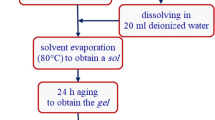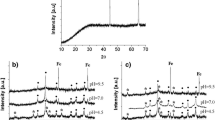Abstract
Coprecipitates of CdII, KI and FeIII with hexacyanoferrate ions [Fe(CN)6]4− have been studied by solid-state electrochemistry (voltammetry of immobilized microparticles), magnetic susceptibility measurements, X-ray powder diffraction, electron spin resonance, Mössbauer and diffuse reflectance spectroscopy. Most suprisingly, all experimental results point to the formation of a continuous series of complex mixed phases without the formation of phase mixtures. Although CdII and FeIII ions differ too much in their ionic radii to allow the formation of simple substitution mixed hexacyanoferrates, they are capable of forming different kinds of complex insertion and substitution mixed crystals because of the zeolitic structure of both the iron and the cadmium hexacyanoferrate. Low cadmium concentrations can be found in the zeolitic cavities of iron hexacyanoferrate (Prussian blue), and they start to widen the lattice and facilitate, at higher concentrations, the direct substitution of high-spin iron(III) ions by cadmium ions. In cases of an excess of cadmium, the formation of cadmium hexacyanoferrate with iron(III) ions in the interstitials of the zeolitic structure is observed. These mixed phases show strong charge transfer bands in the visible range and have the appearance of “diluted” Prussian blue. For the first time, this indicates that the charge transfer between the carbon-coordinated low-spin iron(II) ions and the high-spin iron(III) ions can also occur when the latter are situated in the cavities of a host hexacyanoferrate. In Prussian blue the interstitial iron(III) ions are responsible for a very strong charge transfer interaction between the low-spin iron(II) ions and the nitrogen-coordinated high-spin iron(III) ions. Upon substitution of the very small amount of interstitial iron(III) ions in Prussian blue by potassium and cadmium ions the Kubelka-Munk function diminishes by more than 30%, indicating a tremendous decrease in iron(III)-iron(II) interaction.
Similar content being viewed by others
Author information
Authors and Affiliations
Additional information
Received: 12 November 1997 / Accepted: 5 October 1998
Rights and permissions
About this article
Cite this article
Zakharchuk, N., Naumov, N., Stösser, R. et al. Solid state electrochemistry, X-ray powder diffraction, magnetic susceptibility, electron spin resonance, Mössbauer and diffuse reflectance spectroscopy of mixed iron(III)-cadmium(II) hexacyanoferrates. J Solid State Electrochem 3, 264–276 (1999). https://doi.org/10.1007/s100080050157
Issue Date:
DOI: https://doi.org/10.1007/s100080050157




